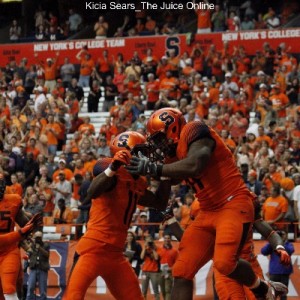

The opening third of the Syracuse football season has passed on schedule and not just in that every game was on played at the time and date posted on the schedule. The Orange started out with three wins in games in which they were favored, then suffered their first loss to an elite team in #8 LSU. Even with that loss, there is a lot to like about what SU has shown to this point.
There is no quit on the team.
In spite of LSU’s dominance on paper (and in reality with Leonard Fournette in the backfield), Syracuse continued to fight on the field throughout the game. With Zack Mahoney starting at quarterback, the team showed up from the opening kick and gave their all, never once letting the gap be more than two possessions until late in the fourth. Even then, they marched for a score and forced the Tigers to cover an onside kick to keep things from getting more interesting.
The week prior, the Carrier Dome turf may as well have been an island in the second half with the length of time the Orange defensive unit was stranded on it, as Central Michigan ran 46 offensive plays compared to SU’s 17 in the third and fourth quarters. With all that stress and time on the field, the defense held up enough to get the game to overtime. (Yes, you are free to say they “blew the lead”, but they got almost literally nothing from the offense, which generated zero first downs in that half.) After all that, they still forced a field goal in overtime, giving their offensive mates a chance to win the game on the ensuing possession. The offense did just that, notching the score that had eluded them the previous two quarters.
The playcalling is not offensive.
Puns about last season aside, new offensive coordinator Tim Lester clearly has the Orange offense miles ahead of where they were last season. Four different quarterbacks have played, ten different non-quarterbacks and non-leaping punters have run the ball, and a dozen different receivers appear on the stat sheet. While the offense has not blown the doors off anyone, it has been effective, and one of the ways it has been effective is giving roles to all those players.
One of those players is Ben Lewis, the second string H-Back (or Express Back, your choice), who has been pressed into a greater role with Erv Philips’ knee injury. While replacing one of the more electric players on the offense, Lewis remains a much greater threat with his hands than his feet, and not just by catching the ball.
Listed at 6’2” and 213 pounds, Lewis is the biggest receiver on the roster who sees regular playing time. Lewis is willing to use that size as a blocker, taking on linebackers and the occasional defensive end to help the Orange ground game, including freeing up pulling linemen to truck opposing defensive backs on the perimeter.
While not the fleetest of foot, Lewis is used frequently in jet sweep action. While not as quick as Philips, by showing that they will give Lewis the ball on a jet sweep, SU forces the opposition must respect that possibility all those times he runs through on a fake. It gives the opponent one more thing to prepare for and defend against. Lewis can also do something with the ball on the ground, as evidenced by a 17-yard scamper against Wake Forest. While the big play is not truly his forte, he can still be effective.
The run defense is pretty darn good.
On the season, the Syracuse defense has given up 408 rushing yards on 134 carries, good for an average of 3.04 yards per carry.
Of course, the NCAA includes quarterback sacks as part of rushing statistics and the SU defense has piled up 11 of those for a loss of 88 yards. When you remove those from the rush defense numbers, what is left is 123 carries for 496 yards, which is an average of 4.03 yards per run.
If you want to go one step further and remove what Leonard Fournette did, you can say that the Orange have allowed 97 rushing attempts for 252 yards to humans (2.58 yards/carry).
To sum up, the run defense is pretty good.
» Related: One third complete, Syracuse football season on track for a bowl game
You have to live with the pass defense.
Here lies the flip side to the run defense: The pass defense is what it is.
And “what it is” is a defense that puts pressure on the opposing quarterback through a wide variety of exotic looks, fakes, and blitzes. Sometimes, the pressure does not get there, resulting in chunks of passing yards allowed, particularly when the back seven (those who don’t blitz, anyway), are in a zone scheme or playing man coverage with a cushion.
Of course, when the pressure does get there, things go south for the opponent’s passing game. Exhibit A: Wake Forest.
In the first half, Demon Deacon quarterback John Wolford was never sacked. He completed 18-of-22 passes for 234 yards, a pair of scores, and a pair of interceptions (on
each of those picks, a Syracuse defender was credited with a quarterback hit, and both times, that pressure led directly to the turnover).
The second half was a markedly different story, as Wolford went 12-of-23 for 139 yards and a win-sealing interception for the Orange. After SU took a lead it would not give up in the third, Wolford went 7-of-15 for 79 yards with that interception while being sacked three times. Those stats include a 3-of-4 stretch for 55 yards in the final meaningless drive with the Orange playing prevent.
By the way, this is not new. In seven years on campus, Scott Shafer’s defense has always run this high-risk, high-reward style. Even with Chuck Bullough taking over defensive coordinator duties when Shafer ascended to the head coach spot, the defense never changed one bit.
The youth movement is here.
Of all those offensive players mentioned above who have taken snaps, carried the ball, or caught a pass, here is a list of those who may not be back next season:
- QB Terrel Hunt
“May not be” is the operative word there, as Shafer announced that SU would pursue a sixth year of eligibility for Hunt. That status will be determined by the NCAA, so Hunt and the Orange will simply have to wait.
Everyone else will return.
The offensive line will lose three major players in longtime starters Ivan Foy, Nick Robinson, and Rob Trudo after the season, but the skill positions are more than covered.
It’s not just the guys on offense, either. Here’s a list of players in the top 18 tacklers on SU’s roster who have one year or less of eligibility after this season ends:
LB Marquez Hodge, CB Julian Whigham, CB Wayne Morgan, DE Ron Thompson, DE Luke Arciniega, DE Donnie Simmons, LB Ted Taylor
Of those players, Whigham is the only one definitely in his last season in Orange. Should Thompson’s production maintain its current level through ACC play (he has five tackles for loss, four sacks, and three forced fumbles in four games), he may declare for the NFL draft.
Everyone else can or will be back. In fact, Simmons is the only question mark, as he will need the NCAA to officially grant a redshirt after he did not play in the 2013 season.
What the youth movement says to potential recruits.
In short, that youth movement says a couple things:
- You can come up and play as a contributor right away.
- You should get on board because this program is ascending.
Oh, that second one goes out to the more casual folks among the fanbase, too.
For more Syracuse coverage, Like our Facebook page and follow us @TheJuiceOnline.

